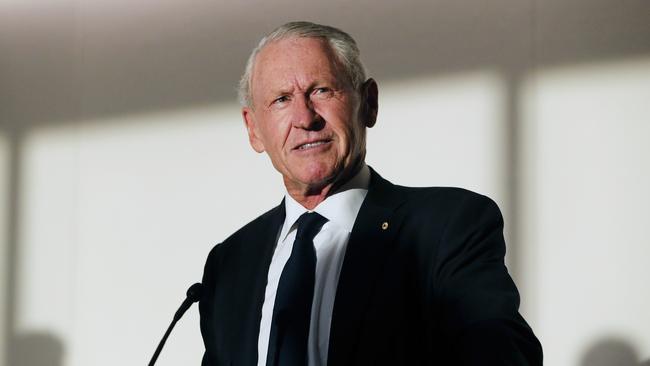Morgan, a one-time Treasury official, retired from Westpac in 2008 just before the Global Financial Crisis hit, but in his time he regularly boasted of lending discipline and bulletproof balance sheets at Westpac – although at times this caution often came at a heavy cost to growth.
Even with the later complexity of the St George merger when the GFC hit, Westpac was one of the few banks still open for business.
Today’s boss King, who worked under Morgan, says the economic clouds are gathering again. He too is probably more cautious than other big four bank bosses about the near-term outlook as interest rates have pushed sharply higher. King believes the Westpac balance sheet is now as “strong as he can ever remember”, moving into a tougher environment. More than $1.5bn has been set aside to cover potential lending losses over and above what is needed in his “base case” scenario of a how a downturn will play out. He is also being careful about chasing mortgage market share, staying at the middle rather than at the sharper end of an intense pricing battle under way.

Even with expectations that the RBA cash rate has peaked at 3.85 per cent, King raises the prospect that Australia is facing a hard landing. There are no meaningful signs of a mortgage stress coming through, but he isn’t taking any chances around the Reserve Bank’s efforts to cool inflation through rapid-fire interest rate hikes.
“We think it’s going to be a soft landing, but we’ve also got to prepare for something that’s a little bit harder than that,” King tells The Australian.
“We haven’t had the rise in interest rates like we’ve had for a long, long time, and things will pop out that you don’t expect”. Here he points to the recent hit to regional banks in the US. Until the middle of March no one was talking about a US banking crisis or large mark-to-market losses on the bond portfolios sitting inside smaller banks there.
“Look what happened with that,” King says. “It’s still early days and it’s not all fed through the system, so it’s probably a good time just to remain cautious”.
The focus on mortgage customers for signs of stress is important but King believes a lot of the potential losses will end up with businesses.
“I think the trend is clear that it’s going to get harder. People are underestimating the speed of the change. If you’ve got a job you prioritise the house or the roof over your head, and you will cut back on everything else”.
Westpac hit the $4bn profit barrier for its first half result, coming in slightly ahead of expectations of $3.9bn. The headline number was up 22 per cent on the same time last year. The interim dividend of 70c a share was up from 61c in the September half. Signs the bank was able to ride out the impact on profit margins from competition on mortgages and deposits helped support its shares. This contrasts with National Australia Bank in recent days, where investors were spooked over margin squeeze.
Cost of caution
Still, as in the Morgan days, all this safety comes at a cost to shareholders. Dividends, while increasing, could be higher and the extra cash sitting in reserve on the balance sheet is weighing down returns.
Westpac has published its forecasts for peak unemployment in 2023 and expects it to move to 5.1 per cent next year. It has also upped this year’s unemployment forecasts to 4.7 per cent from 4.5 per cent previously.
The bank left its GDP growth forecast at 1 per cent for this year before picking up to 1.5 per cent next year. It still expects housing prices nationally to fall almost 8 per cent, with the Sydney market leading the losses.
Westpac nearly doubled its bad debt charge to $390m in the first half, even though problem loans only slightly moved up during the period.
Even so, Westpac, like ANZ and NAB in recent days, is showing almost no signs of lending problems.

Westpac’s level of missed mortgage payments over three months – the biggest indicator that a loan is stressed – fell during the March half, but King noted there was a slight increase in “early cycle” delinquencies. In particular, he is worried about the lag effect as the higher cash rate takes hold.
For the first time since taking charge of Westpac at the very end of 2019, King has stopped talking about “fixing” the bank after the Austrac anti-money laundering legal action three years ago sent it reeling.
The banking major still has work to achieve King’s new ambition of simplicity, including selling off the remaining super platform and the Pacific business.
So too there is a risk around credibility when it comes to pulling out costs. The bank has officially backed away from its hard target of an annualised cost base of $8.6bn by next year. The cost savings figure was released when inflation was running at 0.5 per cent. Since then a multi-decade inflation breakout including a wage hike and supplier pressure has come through and Westpac has been swimming upstream to meet its self-imposed target. At the current run rate, annualised costs are running at just $10bn. This is down from the bloated $13.3bn peak two years ago.
Although the target has been shelved, King says he will continue to tackle costs, with more than $1bn in annualised savings so far.
Gas battle
Jim Chalmers didn’t want to pick a fight with an already aggravated gas sector and an increasingly nervous mining sector on the eve of the budget. Planned changes to the Petroleum Resource Rent Tax see Chalmers moving along the path of least resistance with a compromise on putting a cap on tax deductions to raise $2.4bn over the next four years. Even with gas prices pulling back, this could raise more than $7bn by 2033 and importantly for Chalmers the funds start flowing immediately.
Miners were watching how the gas proposals settled amid concerns a Queensland-style super profit coal tax could be modified by Canberra and slapped on other commodities. Some bank CEOs also fretted about a super-profits tax, but with a commodities windfall to boost the budget the moment looks to have passed.
The changes to the PRRT regime proposed this week by Chalmers were Treasury’s least preferred model. Treasury officials had been eyeing the bigger tax revenue slice on offer of either a netback method or re-cutting the ratio of where earnings are deemed to be made, be it onshore or offshore.
But the 3 per cent share price surge in Woodside and the lift in Santos reflected the relief around PRRT deductions caps, with the bulk of the changes likely to hit international players more, given the life cycle of their projects. Chevron, the owner of the $80bn Gorgon and Wheatstone LNG projects, was the only one prepared to speak out over the changes.
Worley, which undertakes substantial engineering work for the offshore LNG players, rose more than 3.6 per cent.
The changes also show the Albanese government is increasingly concerned about drawing a line through scaring off investment incentives or risks to future energy supply. Indeed there is a realistic chance that the east coast will be a LNG importer from next decade without new gas developments.
The biggest relief is that the new proposals on a deduction cap only apply to projects that have been producing for seven years, which means Woodside’s Browse and Scarborough gas projects won’t fall under the tax net.
Despite the mess of the current tax regime it has still encouraged mega-development and tens of billions of investment, but this has been traded off against smoother tax flows to Canberra over the longer term. Unlike oil, gas projects have a very high up-front cost but a very long life.
All the recent anxiety over PRRT may still be a moot point. The current rules are due to expire in April 2026 which means they will need to be remade and it is very likely the same debate returns again.
johnstone@theaustralian.com.au








Peter King’s instinctive caution has taken hold with the Westpac boss giving a nod to former chief executive David Morgan, who sought to differentiate Westpac through conservative settings when running the lender through most of the 2000s.